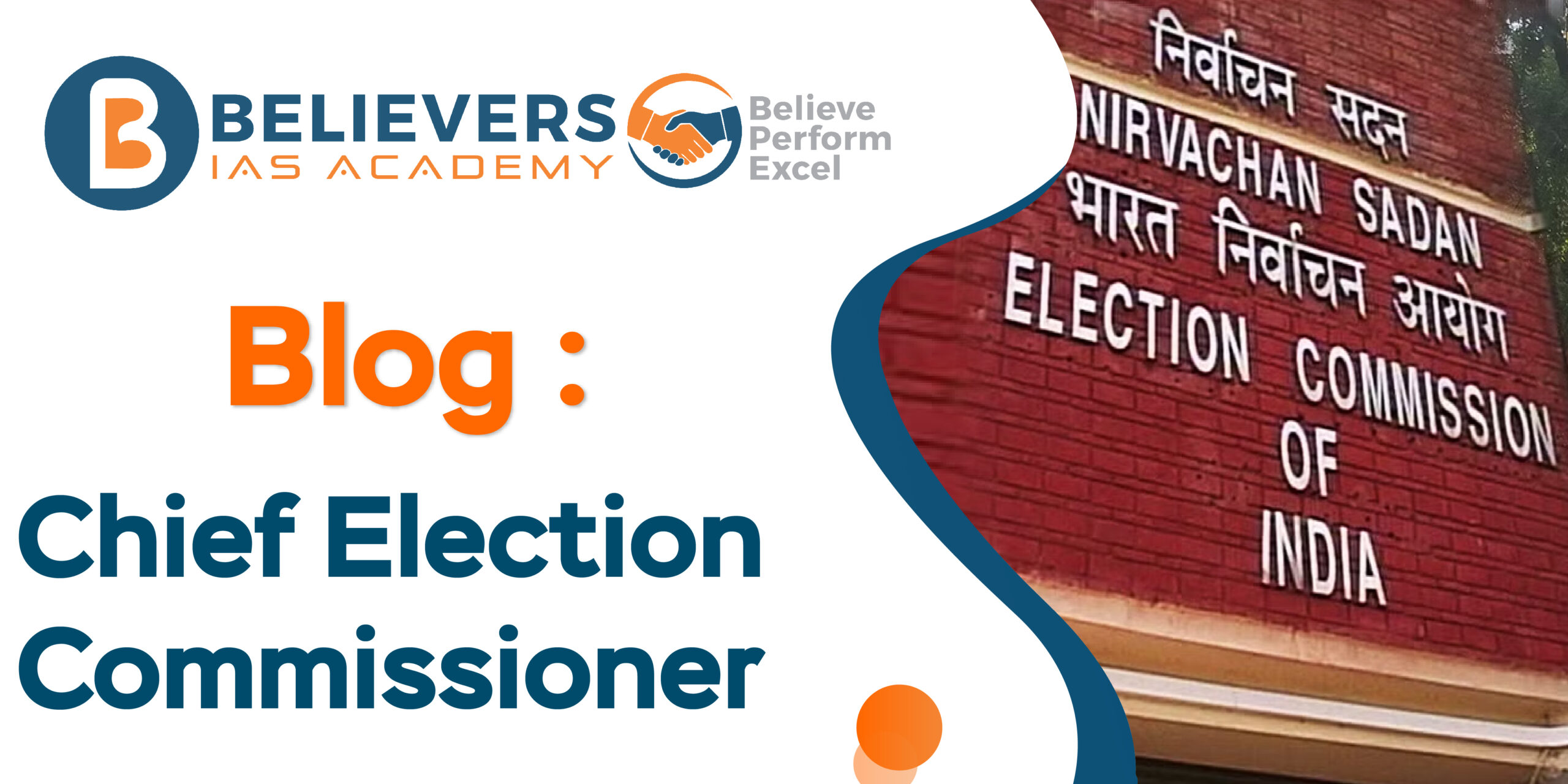Blog: Chief Election Commissioner
The Election Commission of India, a body with constitutional authority to oversee free and fair elections for the President and Vice-President, as well as for state and national legislatures, is headed by the Chief Election Commissioner of India. Article 324 of the Indian Constitution gives the Election Commission of India this authority.
Rajiv Kumar is a former member of the Indian Administrative Service. He succeeded Sushil Chandra on May 15, 2022, becoming India’s 25th Chief Election Commissioner.
What are the roles and responsibilities of CEC?
- Superintendence, Direction, and Control: The CEC supervises, directs, and controls all aspects of the electoral process to guarantee that voting is done quickly, fairly, and impartially.
- Decision-Making: The CEC is responsible for making important election-related decisions, including declaring election schedules, supervising the conduct of elections, and resolving disagreements.
- Model Code of Conduct: To preserve a level playing field and ensure fair procedures, the CEC enforces the Model Code of Conduct, which political parties are obliged to abide by during elections.
- Election Planning: The CEC is in charge of arranging elections for the Lok Sabha (House of the People), Rajya Sabha (Council of States), state legislatures, and the offices of the president and vice president.
- Resolution of problems: The CEC is involved in settling election-related problems, including potential disqualification issues.
- Representation: The CEC speaks on behalf of the Election Commission of India in several national and international venues.
What are the constitutional provisions related to CEC?
The Indian Constitution’s Articles 324 to 329 largely lay out the constitutional provisions about the Chief Election Commissioner (CEC) in India. These clauses outline the responsibilities, authority, and selection of the Chief Election Commissioner. The pertinent articles are as follows:
- Article 324: This article deals with the superintendence, direction, and control of elections to be vested in an Election Commission. It establishes the Election Commission of India and vests it with the authority to oversee and conduct elections.
- Article 324(2): This clause gives the power to Parliament to enact laws regulating matters related to elections, including the appointment of election commissioners. It reads: “The President of India or the Governor of a State shall, when so requested by the Election Commission, make available to the Election Commission or a Regional Commissioner such staff as may be necessary for the discharge of the functions conferred on the Election Commission by clause ( 1 ).”
- Article 325: This article ensures that no person can be disqualified from voting in elections on the grounds of religion, race, caste, sex, or any of them.
- Article 326: This article establishes the principle of adult suffrage, which means that every citizen who is not otherwise disqualified can vote in elections to the House of the People (Lok Sabha) and the State Legislative Assemblies.
- Article 327: This article grants the power to Parliament to make provisions regarding the conduct of elections to the legislatures of the states and the qualifications and disqualifications for membership in such legislatures.
- Article 329: This article bars the interference of courts in electoral matters. It provides a shield against judicial intervention in electoral disputes, ensuring that these matters are resolved within the framework set by the Election Commission.
How is the Election Commission Structured?
The structure of the Election Commission of India (ECI), which consists of three important members, is intended to guarantee impartiality, fairness, and transparency in the conduct of elections.
- Chief Election Commissioner (CEC): The Chief Election Commissioner is in charge of the Election Commission. The CEC is in charge of the Commission’s general operation and decision-making and has the highest power within it. The CEC’s duties include overseeing election procedures, making crucial election-related decisions, and making sure that election-related rules and regulations are followed. The CEC speaks for the Commission and frequently acts as the ECI’s public face.
- Election Commissioners: Two Election Commissioners make up the Indian Election Commission, and they work with the Chief Election Commissioner to carry out the Commission’s tasks. These election commissioners are jointly responsible for making decisions and ensuring fair elections. While the Chief Election Commissioner holds a special status as the head of the Commission, the Election Commissioners contribute equally to its functioning.
How is the CEC appointed and How is he removed from the position?
- Election and CEC commissioners are appointed by the president, who also determines their terms of office.
- Their set term is for six years, or until they reach 65 years old, whichever comes first.
- They have the same privileges and positions as Indian Supreme Court (SC) judges, including the same pay and benefits.
- They have the option to quit at any time or be removed before their term is out.
- Only through a procedure identical to that used by Parliament to remove a SC judge from office can the CEC be removed from office.
What are the Powers and Functions of ECI?
- Supervision, Direction, and Control: The ECI has the power to oversee, direct, and manage every step of the election-conducting process, including the creation of electoral rolls, voting, tallying, and declaring results. This guarantees consistency and impartiality in the voting process nationwide.
- Delimitation of Constituencies: Per the Delimitation Commission Act, the ECI establishes the borders and territorial areas of electoral constituencies for various elections, including those for the Lok Sabha (House of the People) and State Legislative Assemblies.
- Voter Registration: The ECI is in charge of creating and updating electoral rolls, making sure that persons who are eligible to vote are included and those who are not are omitted. The objective is to keep a current and accurate voter list.
- Political Party Recognition: The ECI recognizes political parties per predetermined standards, enabling them to take part in elections and benefit from advantages like reserved symbols. If parties don’t comply with certain requirements, it also has the power to revoke recognition.
- Symbol Allotment: To help political parties and candidates stand out on the ballot, the ECI assigns symbols to each of them. This guarantees that voters can quickly recognize their favourite option.
- Model Code of Conduct: The Model Code of Conduct is a set of rules for political parties and candidates during elections that are enforced by the ECI. It safeguards the integrity of the electoral process and guards against the use of improper influence.
Who were some of the notable CEC of India?
- V. S. Ramadevi, an Indian politician who served as the 8th Governor of Karnataka and 9th Chief Election Commissioner of India from 26 November 1990 to 11 December 1990, was the first woman to hold the position. She was India’s first woman to hold the position of Chief Election Commissioner.
- TN Seshan’s electoral innovations helped him get the most notoriety. He changed the Election Commission of India’s standing and prominence. He uncovered more than a hundred electoral irregularities and changed the electoral system.




